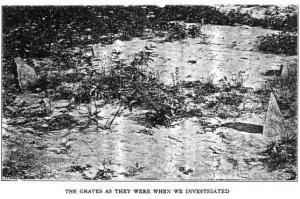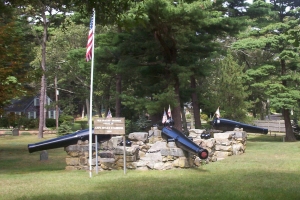The Old Burying Ground in Duxbury, Massachusetts, also known as the Myles Standish Cemetery, is a small, rural graveyard which came into use in the late 1630s. Mayflower passengers who were likely buried there include Myles Standish, John and Priscilla Alden, and George Soule. In 1976 the American Cemetery Association declared it “America’s Oldest Maintained Cemetery” and a plaque pronouncing this title was placed there in 1977. While it seems that a number of sites might be contestants for this claim (certainly Plymouth’s Burial Hill among them), the Myles Standish Cemetery is among the very oldest English colonial burying places in the nation.
The most prominent feature in the Standish Cemetery, as the name would suggest, is a striking monument placed over what is believed to be Myles Standish’s family plot. Appropriately martial in appearance, the monument includes a castellated stone enclosure and four large 19th century cannons and cannon balls from the Boston Navy Yard. The story of how this spot came to be accepted as the resting place of Myles Standish and his family is a strange and intriguing one.
In 1883, the Duxbury Rural Society was established, “to improve and ornament the Town.” Taking on many public projects that the tiny town government could not afford, the Rural Society set out to erect street lamps, plant trees, and place road signs. Two years after its founding, members of the Rural Society began to focus on what was then a somewhat mysterious, overgrown and almost forgotten burying ground.
It was clearly ancient but had been out of use since the 1790s and residents of the late 19th century did not understand or agree on exactly how old it was. The location of the First Meetinghouse in Duxbury (built about 1638 and taken down around 1706) was also up for debate, although it is now accepted that it once stood within the bounds of the Standish Cemetery. Due to all this confusion and lost history, those arguing that the overgrown graveyard on Chestnut Street was, in fact, the town’s first burying ground met with considerable skepticism.
One Duxbury proponent of the hypothesis published an anonymous letter in the Boston Herald, which was reprinted in the New York Times and numerous other papers nationwide, arguing that the spot was not only the town’s first burying ground but also the resting place of Myles Standish and other Mayflower passengers. The April 1887 letter described the burying ground as “overgrown with rank, uncared for grass, interlaced with tangled blackberry vines.”[1] The letter also recounts an oral tradition in the Prior family (who lived adjacent to the burying ground) extending all the way back to an ancestor who purportedly was present when Myles Standish was buried there.
This surge of interest prompted members of the Rural Society to reclaim the cemetery. Brush was removed, stones were righted, and a fence was placed around the cemetery in 1887 and 1888 to protect it from roaming livestock. Members next focused on the question of Myles Standish’s grave.
According to the Prior family tradition, the Captain was buried beneath two rough, pyramid shaped fieldstones. Stones matching this description were located within the Old Burying Ground and members began to press for an exhumation to determine if the folklore was true. Frederick Bradford Knapp, then President of the Rural Society (also Headmaster of Duxbury’s Powder Point School for Boys and former Superintendent of Buildings and Grounds at Harvard), was dubious. He felt the grave of Myles Standish was a distraction from the group’s more important village improvement work. In his 1888 report to the Society, Knapp observed, “During these five years we have…set out trees at about 240 places…set 27 street lamps, have built a fence along the old cemetery…have set out vines and flowers in other parts of the town…have started a [forestry] nursery, and have tried to disturb Myles Standish.”[2]
Despite his lack of enthusiasm for the project, Knapp acquiesced and the Rural Society secured the permission of the Selectmen to dig beneath the mysterious stones. On April 15, 1889, the exhumation proceeded. Beneath the fieldstones, a skeleton of a woman was found and, beside her, the skeleton of a man. Knapp wrote, “Nothing was found to prove that this man was Miles Standish.”[3] The graves were covered over.
Although Knapp wanted to put the matter to rest, others felt that the exhumation had not been thorough enough and pressed for another. They found a champion in Rev. Eugene J.V. Huiginn who became rector of St. John’s Church in Duxbury in 1890. A native of Ireland, he had been educated at the University of Dublin. During his first year in Duxbury, Huiginn exhaustively researched the possible resting places of Myles Standish. Finally, he became convinced that the skeleton that had earlier been exhumed was indeed the Captain of the Pilgrims. He later wrote,
I concluded that the searching party of 1889 ought to have opened more graves…It is strange, when you think of it, that a company of educated, thoughtful people should have discontinued the search just at the moment when their efforts would have been crowned by success…My evidence all being prepared, I was anxious to get permission to open the graves.[4]

The Standish grave site as it appeared prior to the placement of the monument. The mysterious pyramid shaped fieldstones seen here are still present within the new enclosure.
And so, in 1891, Huiginn, having been elected President of the Rural Society over Knapp, obtained permission to open the graves again. On April 25, 1891, they opened a larger area and several graves, discovering that the male skeleton had been buried between two women (consistent with Standish’s request in his will to be buried between his daughter and daughter-in-law). They also found the remains of two boys whom Huiginn concluded were Charles and John Standish, the Captain’s sons, both of whom had died young. Examining the remains of the man believed to be Captain Standish, a doctor proclaimed that he had been a man of great physical strength. Hair still remaining on the skull was red and gray. And Huiginn was impressed by the fact that the shape of the skull was remarkably similar to the features of a Standish descendant then present.[5]
Feeling confident that he had indeed found Myles Standish, Huiginn now sought to erect a memorial on the site. This prompted more controversy as opponents argued that a village improvement society should not be spending their limited funds on historical markers. In the course of the backlash, a majority of the members of the Rural Society sought to wipe their hands of the matter of Myles Standish’s grave in 1892 and the organization voted to declare all previous votes on the matter null and void.[6] The disagreement grew so bitter that 24 members (a large portion of the membership) of the Rural Society who were in favor of erecting the memorial bolted the organization and formed the Duxbury Historical and Antiquarian Society. The new group sought donations towards the Standish gravesite monument which was completed in 1893 at the cost of $364. The DHAS was short lived. Eventually the Rural Society altered its by-laws to allow historical projects and the splinter group rejoined the ranks of the Rurals. The organization is now known as the Duxbury Rural and Historical Society.
Forty years after the exhumations, in 1931, a 74 year-old Frederick Bradford Knapp observed the third opening of a grave he had never wished disturbed in the first place. The Selectmen had become convinced that it had been a mistake to replace Myles Standish’s remains in a wooden coffin. The goal of the third exhumation was to place the Captain’s bones in a hermetically sealed copper box which would then be placed in a new cement chamber, preserving them for eternity.[7] In contrast to the previous, fairly private exhumations, the final dig was attended by a large crowd and representatives of many civic groups.
The grave was sealed and now, finally, Myles Standish may rest in peace. However, it might be noted that, during the 1931 re-interment, mementos of a time capsule nature were also deposited in the cement chamber indicating that some participants, perhaps, presumed the resting place of Myles Standish might, at some unknown point in the future, be uncovered a fourth time.
[1] “Miles Standish’s Grave,” New York Times, April 6, 1887
[2] Minutes of the Annual Meeting of the Rural Society, 1888, Archives of the Duxbury Rural and Historical Society
[3] Minutes of the Duxbury Rural Society, May 18, 1889, Archives of the Duxbury Rural and Historical Society
[4] Rev. E.J.V. Huiginn, The Graves of Myles Standish and Other Pilgrims, [1892], p. 120
[5] Huiginn, p. 126-127
[6] Minutes of the Duxbury Rural Society, August 29, 1892, Archives of the Duxbury Rural and Historical Society
[7] “Myles Standish Dug Up,” Duxbury Clipper, May 19, 1977


May 29th, 2014 at 12:41 am
I was living in Duxbury during the turn of the century – and was told by a member of the Alden Kindred. That Priscilla Alden’s body’s whereabouts are unknown. Is this true?
May 29th, 2014 at 5:58 pm
To the best of my knowledge, the precise location of John and Priscilla’s graves are unknown but it is more or less accepted that they were buried in the Old Burying Ground in Duxbury. Stones were placed by the Alden Kindred in memory of John and Priscilla in the vicinity of their children and grandchildren.
January 18th, 2015 at 7:27 pm
[…] [3] For more on Myles Standish’s grave see Opening the Grave of Myles Standish. […]
January 24th, 2015 at 5:27 pm
Did anyone take DNA of Myles Standish? If my records are correct he is directly in my family line. Wouldn’t there be a match up between us and him? If it did then couldn’t that prove that it is Myles in that grave?
January 24th, 2015 at 6:58 pm
As far as I know, no remains of Myles Standish were removed from the grave. So, no DNA testing would be possible.
May 9th, 2022 at 9:33 am
Very interesting story and well written. Greetings from Holland